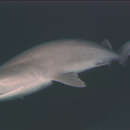Biology
provided by Arkive
Very little is known about this shark's social and mating behaviour, but they are thought to be solitary, coming together only to mate. Males are believed to nip a female's fins to entice her into mating (2). Reproduction in this shark is ovoviviparous; the young hatch from eggs retained within the mother so that she then gives birth to live young (2) (3). The exact gestation period is unknown, but it is thought to be longer than two years. Each litter can number from 22 to 108 pups and this incredibly large litter size suggests that juvenile mortality rates are high (2). Age determination is difficult in this species but males are believed to mature at 11 to 14 years, females at 18 to 35 years, and longevity to reach 80 years for both sexes (3).
The bluntnose six-gill shark is a skilled predator and may also scavenge, feeding nocturnally on a wide variety of marine organisms including other sharks, rays, bony fishes, squid, crabs, and seals (1) (2). Although reported as being sluggish in nature, they can reach remarkable speeds when chasing prey (2).
Conservation
provided by Arkive
As the bluntnose six-gill shark is relatively widespread and abundant, there is no legislation against the commercial fishing of this species. There are, however, new regulations being enacted prohibiting the recreational killing of these sharks in some areas of its range (2). The Food and Agriculture Organisation of the United Nations (FAO) have been working on an International Plan of Action for the conservation and management of sharks throughout the world (IPOA-SHARKS) (6), but the lack of sufficient population data on these sharks makes developing appropriate conservation management plans extremely difficult. Furthermore, being mainly deepwater sharks with shy demeanours, opportunities to study live specimens are rare (2). Thus, data on population numbers and distribution is urgently needed to enable this reclusive shark to be effectively monitored and protected.
Description
provided by Arkive
As its common name alludes, the bluntnose six-gill shark has a characteristically blunt rounded snout and six long gill slits on either side of its head, instead of the five that are usual amongst sharks (2). Other distinguishing features include its fluorescent green eyes, six saw-like teeth on each side of the lower jaw and the singular dorsal fin located close to the caudal fin (3). Colouring ranges from greyish-black to chocolate brown on the back, lightening to a greyish white underside, with a distinctive light stripe along the sides and white edging on the fins (4). Females tend to be slightly larger than males (2).
Habitat
provided by Arkive
A reclusive deepwater species, found in the waters of continental and insular shelves and upper slopes (4). Juveniles may be found closer inshore while adults occupy deeper waters (1). This shark rests along the bottom during the day to depths of 2,000 meters, swimming close to the surface at night to feed (4).
Range
provided by Arkive
The bluntnose six-gill shark is one of the wider ranging sharks, occupying temperate and tropical seas around the world (3).
Status
provided by Arkive
Classified as Lower Risk/near threatened (LR/nt) on the IUCN Red List (1).
Threats
provided by Arkive
The bluntnose six-gill shark is fished commercially and as a game fish throughout its range (3). However, the species seems unable to sustain target fisheries and is more usually taken as bycatch (1). The flesh is sold fresh, frozen and dried-salted for consumption, and is also utilised for oil and fishmeal (5). In parts of its range, including the Northeast Pacific, regional populations have depleted so much from fishing that they would be better classified as Vulnerable (A1bd+2bd) (1). Because of their relatively low reproductive rate these sharks are slow to rebound if over fished (2).

